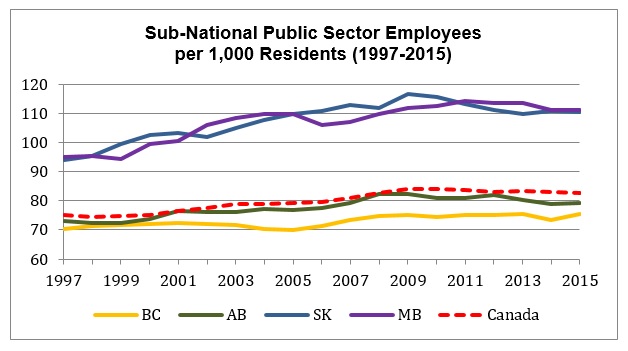The Frontier Centre for Public Policy and The Atlantic Institute for Market Studies (AIMS) today jointly released The Size and Cost of the Public Sector in Western Canada, authored by Rodney A. Clifton, Jackson Doughart, and Marco Navarro-Génie.
This study examines the provincial and municipal public sectors in Alberta, British Columbia, Manitoba, and Saskatchewan in the year 2015. The authors draw data from Statistics Canada and examine the share of the overall workforce in the public sector, the number of public sector employees per 1,000 residents, and the share of the total compensation awarded to public sector workers.
Public sector employment is a major cost for all levels of government. This study shows that the number of municipal and provincial public sector workers is much higher in Manitoba and Saskatchewan than in Alberta and British Columbia. In fact, Manitoba and Saskatchewan have 111 public sector employees per 1,000 residents, while Alberta has 79 and British Columbia has 76.
The paper also finds that the size of public sectors in Manitoba and Saskatchewan has grown at roughly twice the pace of the public sector in Alberta since 1997 — the first year for which these Statistics Canada data are available. On a per-capita basis, Manitoba’s and Saskatchewan’s public sectors have grown 17 per cent and 18 per cent, respectively, while Alberta’s and B.C.’s have grown eight per cent and seven per cent. Canada-wide, per capita sub-national public employment has grown 10 per cent.

Media should note that the study’s figures include municipal and provincial-level public servants paid directly by government. Examples include healthcare workers, educators, regulators and members of the bureaucracy, police officers, judges, court officials, and deliverers of government services. They do not include the employees of crown corporations – businesses wholly or partially owned by the state – or private industry that is subsidized by government.
The authors recommend that the provincial governments in Manitoba and Saskatchewan reduce the number of public sector workers, and thus reduce government expenditures. This policy would provide substantial savings for the cost of government.
Read the entire paper here: PS194_SizeCostPSWest_CF1



